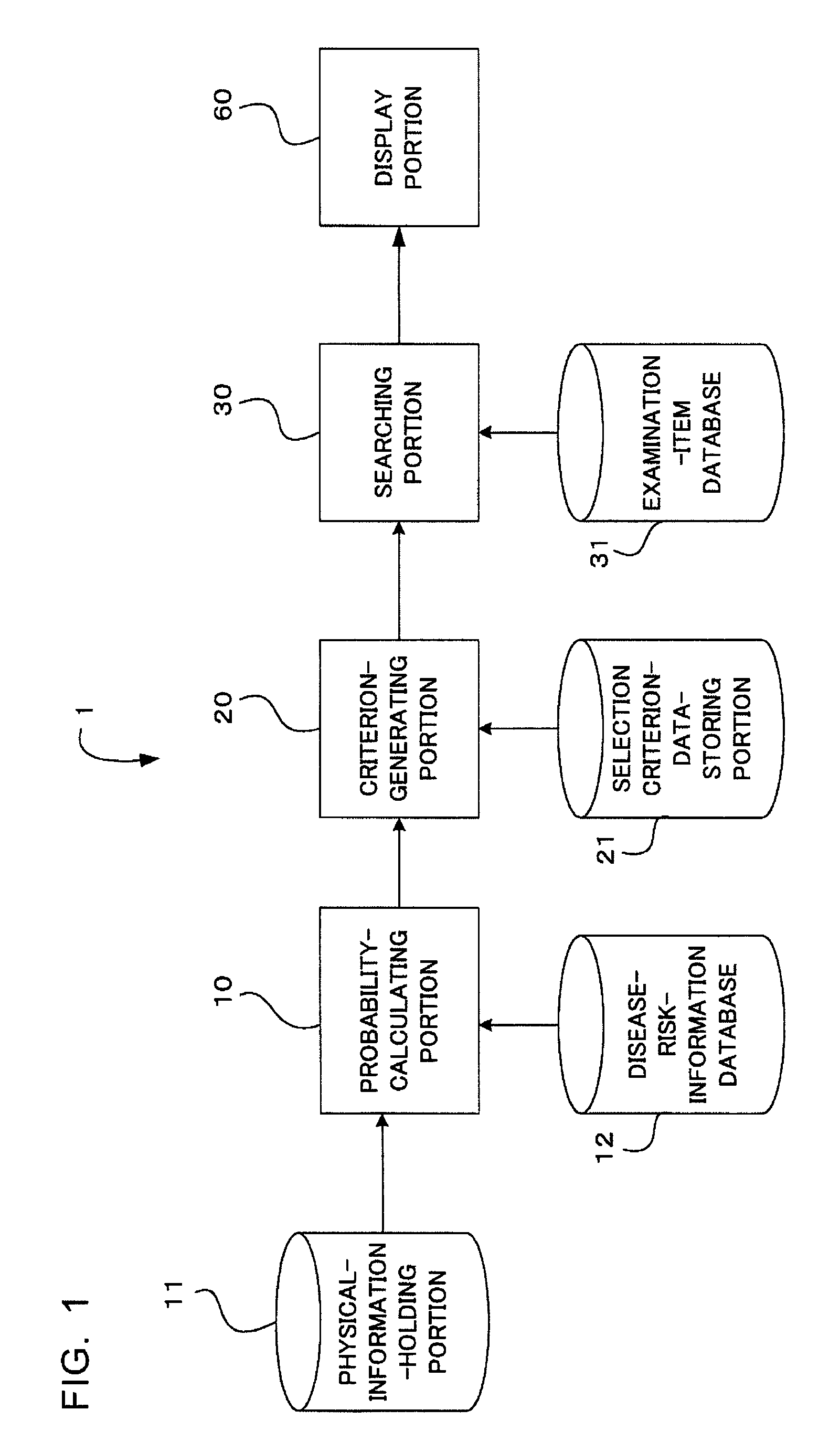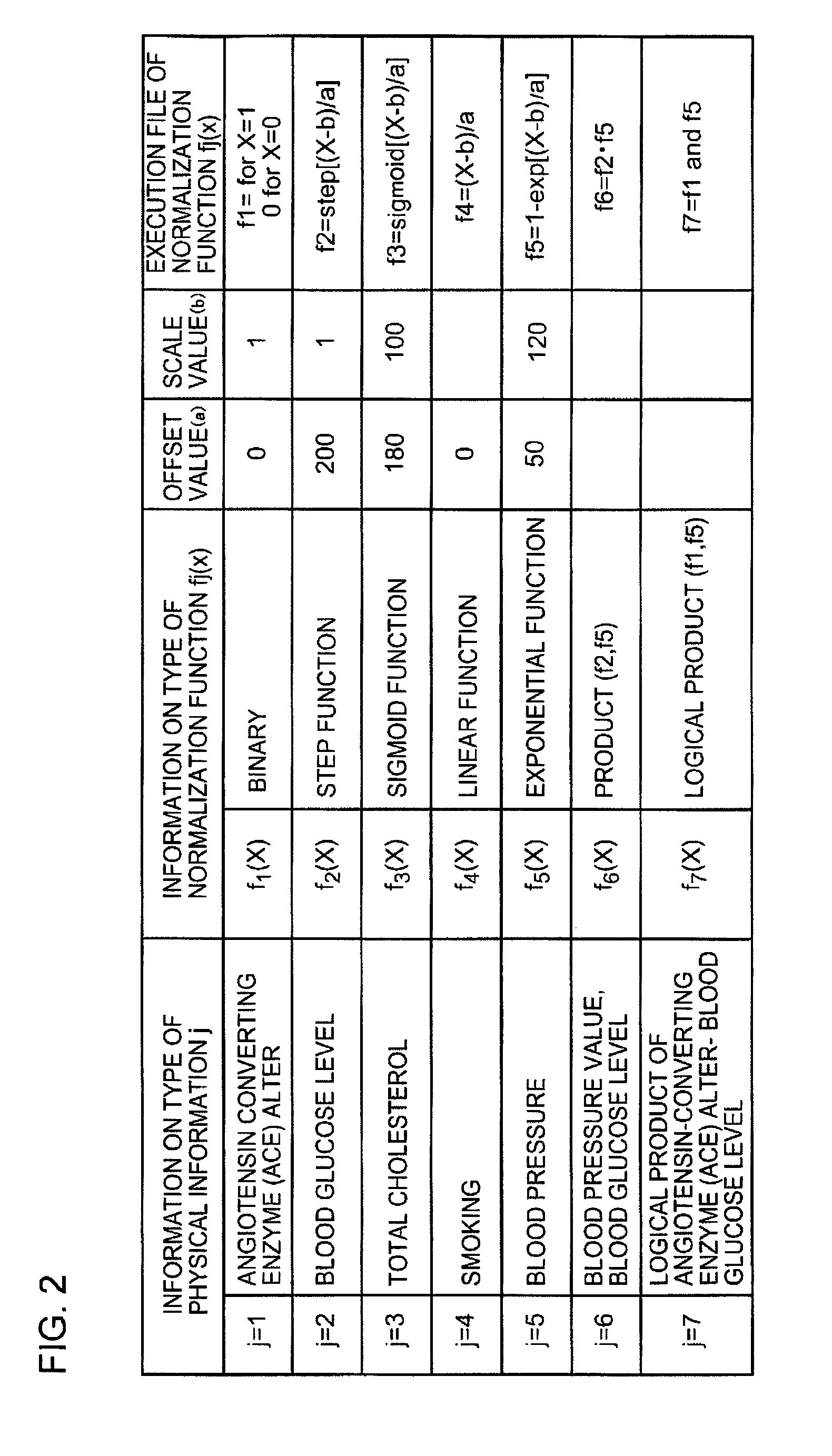Examination-item-selection device, an examination-item-selection method, and an examination-item-selection program
a technology of examination items and selection methods, applied in the field of examination items selection devices, examination items selection methods, examination items selection programs, etc., can solve the problems of imposing on the individual superfluous physical, psychological and even financial burdens, many diseases may be missed, and it is difficult to predict the type of disease that will develop, so as to improve the efficiency of disease detection and reduce the burden of physical and psychological burdens imposed, the effect of reducing the number of superfluous examinations
- Summary
- Abstract
- Description
- Claims
- Application Information
AI Technical Summary
Benefits of technology
Problems solved by technology
Method used
Image
Examples
first embodiment
[0040]An examination-item-selection method according to a first embodiment is to predict the degree of risk for developing various diseases in a statistical approach based on individual physical information, generate a criterion for selecting examination items according to the predicted degree of risk, and select an examination item that has an attribute satisfying the selection criterion.
[0041]The degree of risk for developing a disease is the probability that expresses development of the disease in percentage, or sections such as high, middle and low. The attributes of the examination items to be used in selection of an examination item are, for example, the examination accuracy, the cost of the examination, the dangerousness of the examination, the invasiveness caused by the examination, the reliability of the examination, the examination time, the physical and psychological burdens imposed by the examination, and so on, and they are represented by quantifying or sectionalizing. ...
second embodiment
[0072]The examination-item-selection device 1 according to a second embodiment of the present invention is explained. This examination-item-selection device 1 is the same as that of the first embodiment in the configuration for calculating the disease-development probability in a statistical approach by using the disease-risk information from the physical information, generating the selection-criterion information according to the disease-development probability by using the selection criterion data, and selecting an examination item having an attribute satisfying the selection-criterion information. The examination-item-selection device 1 according to the present embodiment materializes a physical-information-holding portion 11, a disease-risk-information database 12 and a probability-calculating portion 10 in order to calculate the disease-development probability by executing a program. In addition, the device comprises a selection criterion-data-storing portion 21, a criterion-ge...
third embodiment
[0085]In a third embodiment of the present invention, the searching portion 30 compares the cost Ce of each examination item associated with the searched-out disease i and the expected value, picks out the examination item that is associated with the cost Ce below the expected value and associated with the highest examination-accuracy rank R, and displays the examination item on the initial screen, where it is possible to switch the display to another examination item associated with the disease i by using the input interface.
[0086]FIG. 14 is a diagram that represents the examination-item-selection result displayed in the present embodiment. In the initial state, as shown in FIG. 14A, the searching portion 30 displays, on the monitor, the disease i, the disease-development probability of the disease i, the searched-out examination item associated with the highest examination-accuracy rank R, and the examination-accuracy rank R, in combination. The searching portion 30 displays, in a...
PUM
 Login to View More
Login to View More Abstract
Description
Claims
Application Information
 Login to View More
Login to View More - R&D
- Intellectual Property
- Life Sciences
- Materials
- Tech Scout
- Unparalleled Data Quality
- Higher Quality Content
- 60% Fewer Hallucinations
Browse by: Latest US Patents, China's latest patents, Technical Efficacy Thesaurus, Application Domain, Technology Topic, Popular Technical Reports.
© 2025 PatSnap. All rights reserved.Legal|Privacy policy|Modern Slavery Act Transparency Statement|Sitemap|About US| Contact US: help@patsnap.com



